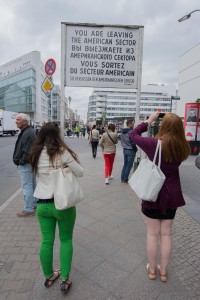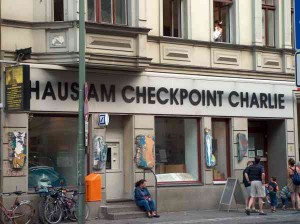by Katie Pflug
Checkpoint Charlie was once a main crossing point between East and West Berlin and the Berlin Wall, but today it is a main historical attraction in Berlin, Germany.
The Checkpoint Charlie Museum may look like an old-fashioned home, but it is filled to the brim with historical remembrance of East and West Berlin.
Located near Potsdamer Platz, the Checkpoint Charlie Museum was erected in 1962 by freedom-fighter founder and director Dr. Rainer Hildebrandt. The museum started as a two and a half room apartment display that held history about the Berlin Wall. On June 14, 1962, the museum reopened in Friedrichstrasse in what used to be a block of flats, at the Checkpoint Charlie border crossing. Today it displays objects that helped escapees flee the East, exhibits to learn more about the history of the Berlin Wall and stories of escapees, according to its website.
Today the museum is run by Hildebrandt’s widow, Alexandra Hildebrandt, who, since the death of her husband in 2004, has expanded the museum to include more exhibitions about human rights and freedom.
The permanent exhibition dates back to the museum’s first days, just after the building of the Berlin Wall, and charts the lifespan of the world’s supposedly most secure border system, according to its website. Here visitors can see original boards created by Hildebrandt in the 1960s, who worked with journalists, escape organizers and protesters to put together a compact and clear outline of the background to the wall’s creation, as well as other key events in East Germany’s history, such as the June 17, 1953, uprisings.

Katie Pflug and Michelle Graessle stop for a photo of the American sector exit sign.
(photo by Connor Mulvaney)
After viewing the first room, visitors walk up a staircase that has children’s paintings all the way up to the top of the stairs. Each of the paintings explains the separation between East and West Germany and how children wish they could all be friends. The paintings and drawings add a child’s perceptive to the museum, which gives visitors another great way to think about how the Berlin Wall affected so many people’s lives.
Throughout the whole museum there are many displays that shows objects that helped East Berliners escape to the west. From suitcases and heaters to escape cars, hot air balloons, homemade mini-submarines and deceptively hollow surfboards are just a few of the items that people used to escape. Reading the stories left many visitors looking shocked.
The museum displays a homemade airplane that was used as an escape method. The only part of the plane that was not homemade was the engine, which was taken out of a car.
The museum also has on exhibit other work describing human rights violations around the world and a permanent NATO exhibition.
Point Park students found the Checkpoint Charlie Museum a great way to learn more about what was happening while the wall was up in Berlin. The museum is heavy on reading, student visitors said, but each and every display is worth taking the time to read and understand.
The museum is open every day of the year from 9 a.m. until 10 p.m., including festivals such as Christmas and Easter and other bank holidays. Admission charges are 12.50 euros for adults, 8.50 euros for groups of 20 or more, and 9.50 for students and 6.50 for ages 7-18. Children up to 6 are free. Guided tours are available.
